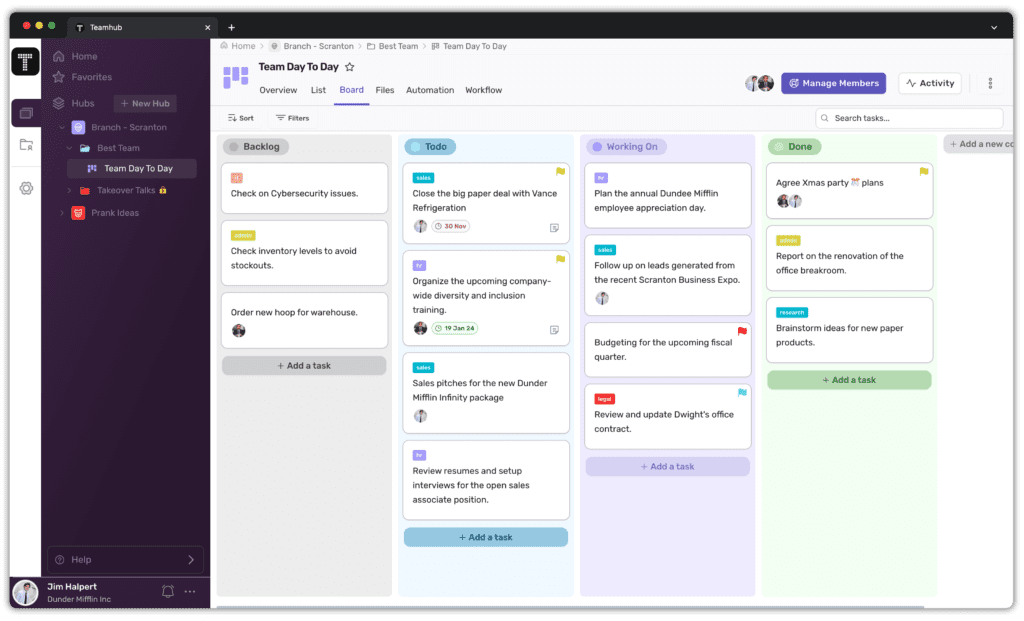LIMITED TIME OFFER
Replace all of these

with a single tool for just $1 per month for your entire team
UNLIMITED USERS
UNLIMITED PROJECTS
UNLIMITED CHATS
UNLIMITED DOCS
UNLIMITED STORAGE
AND MORE..
Stakeholder Power-Interest Grid Explained

The stakeholder power-interest grid is a valuable tool used in strategic management to assess the influence and interest of stakeholders in an organization or project. By analyzing stakeholders based on their power and level of interest, businesses can effectively prioritize and manage their relationships with different groups. This article aims to provide a comprehensive understanding of the stakeholder power-interest grid, its components, and its role in strategic management.

Understanding the Concept of Stakeholder Power-Interest Grid
In today’s complex business environment, organizations must consider the expectations and needs of various stakeholders. The stakeholder power-interest grid helps businesses identify and categorize these stakeholders based on their power and interest in the organization or project.
At its core, the power-interest grid is a visual representation that places stakeholders into four different quadrants, each representing a specific category based on their power and interest levels.
Definition and Importance of Stakeholder Power-Interest Grid
The stakeholder power-interest grid is a strategic management tool that allows organizations to assess the significance of stakeholders and determine appropriate engagement strategies. It is crucial for businesses to understand and engage with stakeholders effectively to achieve their strategic objectives.
By utilizing the power-interest grid, organizations gain valuable insights into who their most influential stakeholders are and develop strategies to manage their expectations and build strong relationships.
The Components of Stakeholder Power-Interest Grid
In order to construct the power-interest grid, businesses must consider two key components: power and interest.
Power
Power refers to the level of influence a stakeholder has over an organization or project. This can include factors such as financial resources, expertise, political connections, or decision-making authority.
Influence
Interest, on the other hand, represents the degree to which stakeholders are personally affected by the organization or project. This can include their level of involvement, potential benefits, or risks associated with the endeavor.
Financial resources
When it comes to power, stakeholders can exert their influence in various ways. For example, stakeholders with significant financial resources can use their monetary leverage to sway decisions in their favor. Similarly, stakeholders with expertise in a particular field can provide valuable insights and guidance to the organization, influencing the direction of projects and initiatives.
Political connections
Political connections can also be a source of power for stakeholders. Individuals who have strong relationships with key political figures or decision-makers may have the ability to shape policies or regulations that impact the organization. This type of power can significantly affect the organization’s operations and strategic decisions.
Decision-making authority
Decision-making authority is another important aspect of power. Stakeholders who hold positions of authority within the organization or have the ability to make critical decisions can directly influence the direction and outcomes of projects. Their decisions can have far-reaching consequences, making it essential for organizations to understand and manage their expectations.
Stakeholders’ interest
On the other hand, stakeholders’ interest in the organization or project is equally important. The level of interest can vary depending on the extent to which stakeholders are personally affected by the organization’s activities.
Some stakeholders may have a high level of involvement in the organization, either as employees, customers, or suppliers. These individuals or entities have a vested interest in the organization’s success and may actively participate in its activities. Their involvement can range from providing feedback and suggestions to actively promoting the organization’s products or services.
Other stakeholders may have a more indirect interest in the organization. For example, community members living near the organization’s facilities may be concerned about the environmental impact of its operations or the potential risks it poses to their well-being. These stakeholders may not have a direct involvement in the organization’s activities but are still affected by its actions.
Furthermore, stakeholders may have different expectations and potential benefits associated with the organization or project. Some stakeholders may expect financial returns or business opportunities, while others may prioritize social or environmental benefits. Understanding these expectations is crucial for organizations to effectively engage with stakeholders and align their strategies with their needs and interests.
In conclusion, the stakeholder power-interest grid is a valuable tool for organizations to assess and categorize stakeholders based on their power and interest levels. By understanding these components, businesses can develop effective engagement strategies, manage stakeholder expectations, and build strong relationships. This ultimately contributes to the achievement of strategic objectives and long-term success.
Unlock Efficiency with Teamhub

The Four Quadrants of the Power-Interest Grid
Once the power and interest of stakeholders have been assessed, they can be placed into four distinct quadrants within the power-interest grid.

High Power, High Interest Stakeholders
High power, high interest stakeholders are individuals or groups who possess significant influence over the organization or project and have a vested interest in its outcomes. Engaging with these stakeholders is paramount to success, as their support or opposition can have a substantial impact.
These stakeholders often include key decision-makers, such as executives, board members, or government officials. Their opinions and actions can shape the direction of the organization or project. It is crucial to build meaningful relationships with them, understand their priorities, and involve them in decision-making processes.
Regular communication and keeping them informed of important developments are essential. By addressing their concerns and seeking their input, you can ensure that their interests are considered, and their support is maintained.
High Power, Low Interest Stakeholders
High power, low interest stakeholders are those who have the ability to exert significant influence but may not have a direct interest in the organization or project. While their involvement might not be as critical as high power, high interest stakeholders, it is still important to keep them engaged and informed.
These stakeholders can include regulatory bodies, industry experts, or influential individuals who may not have a personal stake in the project but can impact its success. To manage this group effectively, it is crucial to provide periodic updates and engage them when necessary.
Developing a cordial relationship and keeping them informed of any relevant developments can help maintain a positive working relationship. While excessive attention might not be required, it is essential to ensure that they are aware of the project’s progress and any potential implications for their areas of interest.
Low Power, High Interest Stakeholders
Low power, high interest stakeholders are individuals or groups with a significant interest in the organization or project but do not possess considerable influence. Although they may not have the power to make decisions, their support can be valuable.
This group often includes employees, customers, or community members who are directly affected by the organization’s activities. While they may not hold positions of authority, their opinions and satisfaction can impact the organization’s reputation and long-term success.
Engaging these stakeholders by soliciting their input, addressing their concerns, and providing them with regular updates can help manage their expectations and ensure their interests are considered. By involving them in decision-making processes and seeking their feedback, you can foster a sense of ownership and demonstrate that their voices are valued.
Low Power, Low Interest Stakeholders
Low power, low interest stakeholders have minimal influence and interest in the organization or project. While their involvement may not be crucial, it is still essential to maintain a positive relationship to prevent any potential negative repercussions.
This group can include individuals or organizations that are indirectly affected by the project or have a peripheral interest. Examples may include suppliers, neighboring businesses, or non-governmental organizations.
Regular communication, providing them with relevant information, and acknowledging their input, albeit to a lesser extent, can help foster goodwill and avoid discontent. By keeping them informed of any potential impacts or changes, you can mitigate any potential misunderstandings or conflicts that may arise.
While their power and interest may be low, it is important to remember that even seemingly insignificant stakeholders can have unexpected influence or become more engaged if their interests are not adequately addressed.
The Role of the Power-Interest Grid in Strategic Management
Identifying Key Stakeholders
One of the primary functions of the power-interest grid is to identify key stakeholders who have a significant impact on the organization or project. Recognizing and understanding these stakeholders allows businesses to allocate resources and tailor engagement strategies effectively.
By assessing stakeholders based on their power and interest, organizations can identify those who require more attention and prioritize their engagement efforts accordingly.

Prioritizing Stakeholder Engagement
Another crucial role of the power-interest grid is in prioritizing stakeholder engagement. By understanding the level of influence and interest of different stakeholders, businesses can determine the appropriate level of engagement and resource allocation.
This helps organizations focus their efforts on stakeholders who have the most significant impact, while ensuring that stakeholders with lesser influence or interest are not neglected.
Managing Stakeholder Expectations
The power-interest grid also serves as a tool to manage stakeholder expectations effectively. By categorizing stakeholders based on their power and interest, businesses can anticipate their needs, concerns, and potential demands.
Understanding their expectations helps in tailoring communication, addressing potential issues, and managing conflicts that may arise during the course of the organization or project.
Constructing a Power-Interest Grid
Steps to Create a Power-Interest Grid
Constructing a power-interest grid involves several key steps that an organization can follow to ensure an effective analysis of stakeholders.
- Identify stakeholders: Begin by identifying all the stakeholders relevant to the organization or project.
- Assess power: Determine the level of power or influence that each stakeholder possesses.
- Assess interest: Evaluate the interest or level of involvement that each stakeholder has in the organization or project.
- Categorize stakeholders: Place stakeholders into the appropriate quadrants of the power-interest grid based on their assessed power and interest.
- Review and update: Regularly review and update the power-interest grid to reflect any changes in stakeholder dynamics.
Tools and Techniques for Grid Construction
Various tools and techniques can be employed to aid in the construction of the power-interest grid:
- Stakeholder analysis: This involves gathering information about each stakeholder, including their power, interest, relationships, and concerns.
- Interviews and surveys: These methods allow for direct engagement with stakeholders to gather data on their power and interest levels.
- Expert opinions: Seeking the input of individuals with expertise in stakeholder management can provide valuable insights for constructing the power-interest grid.
- Internal data analysis: Reviewing internal documents, project reports, and performance data can help identify stakeholders and assess their power and interest.
In conclusion, the stakeholder power-interest grid is a vital tool for organizations to assess, categorize, and effectively engage with stakeholders. By analyzing stakeholders based on their power and interest, businesses can prioritize their efforts and manage relationships in a strategic and effective manner. Understanding the components of the power-interest grid, the four quadrants, and the role it plays in strategic management can help organizations navigate the complex landscape of stakeholder dynamics. Through the careful construction of the power-interest grid, businesses can achieve stakeholder engagement that aligns with their strategic objectives.


